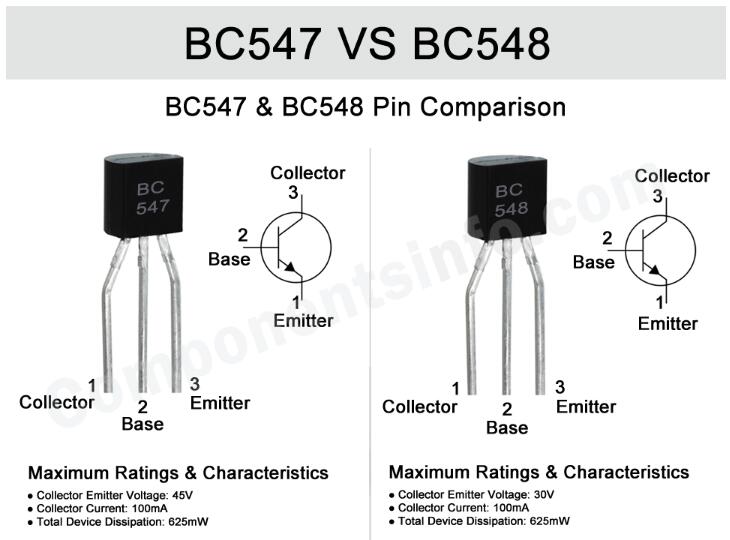The BC547 and BC548 transistors are both NPN bipolar junction transistors (BJTs) commonly used in low-power amplification and switching applications. While they share many similarities, there are some key differences between the BC547 and BC548 transistors. Here's an overview of their characteristics:

BC547: The BC547 is an NPN transistor with the following specifications:
-
Maximum Collector Current (IC): The BC547 typically has a maximum collector current rating of 100 mA (milliamperes). This rating determines the maximum current allowed to flow through the transistor's collector terminal without causing damage.
-
Maximum Collector-Emitter Voltage (VCEO): The BC547 generally has a maximum collector-emitter voltage rating of 45 volts. It indicates the maximum voltage that can be present across the collector-emitter junction without risking damage to the transistor.
-
Current Gain (hFE or β): The current gain of the BC547 transistor typically ranges from 110 to 800. This parameter represents the amplification capability of the transistor, showing the ratio of the collector current (IC) to the base current (IB).
BC548: The BC548 is also an NPN transistor commonly used in low-power applications. Here are its specifications:
-
Maximum Collector Current (IC): The BC548 has the same maximum collector current rating as the BC547, which is 100 mA.
-
Maximum Collector-Emitter Voltage (VCEO): The BC548 typically has a maximum collector-emitter voltage rating of 30 volts, which is lower than the BC547's rating of 45 volts.
-
Current Gain (hFE or β): The current gain of the BC548 transistor falls within the same range as the BC547, typically between 110 and 800.
Ratings & Characteristics Comparison:
| Ratings & Characteristics | BC547 | BC548 |
|---|---|---|
| Collector-Emitter Voltage (Vceo) | 50V | 30V |
| Collector Current (Ic) | 100mA | 100mA |
| Total Device Dissipation (PD) | 625mW | 625mW |
| DC Current Gain (hFE) | 110 To 800 | 110 To 800 |
| Frequency (fT) | 300 MHz | 300 MHz |
Differences:
-
Maximum Collector-Emitter Voltage: One significant difference between the BC547 and BC548 is the maximum collector-emitter voltage rating. The BC547 can handle higher voltage levels (up to 45 volts) compared to the BC548, which has a lower rating of 30 volts. This means that the BC547 is designed to operate within a higher voltage range.
-
Voltage Compatibility: Due to the higher maximum collector-emitter voltage rating, the BC547 may be more suitable for applications that require handling higher voltage levels than what the BC548 is capable of.
Similarities:
-
Maximum Collector Current and Current Gain: The BC547 and BC548 transistors share the same maximum collector current rating of 100 mA, which means they can handle the same maximum current levels. Additionally, they have similar ranges for current gain (hFE or β), typically ranging from 110 to 800.
-
NPN Transistor Type: Both the BC547 and BC548 transistors are NPN transistors with similar pin configurations and functionality. They have three layers, with a negatively-doped layer sandwiched between two positively-doped layers.
When selecting a transistor for a specific application, consider these differences and similarities to ensure the transistor meets the required voltage, current, and amplification requirements of the circuit. Always refer to the datasheets provided by the manufacturer for detailed specifications and information.



